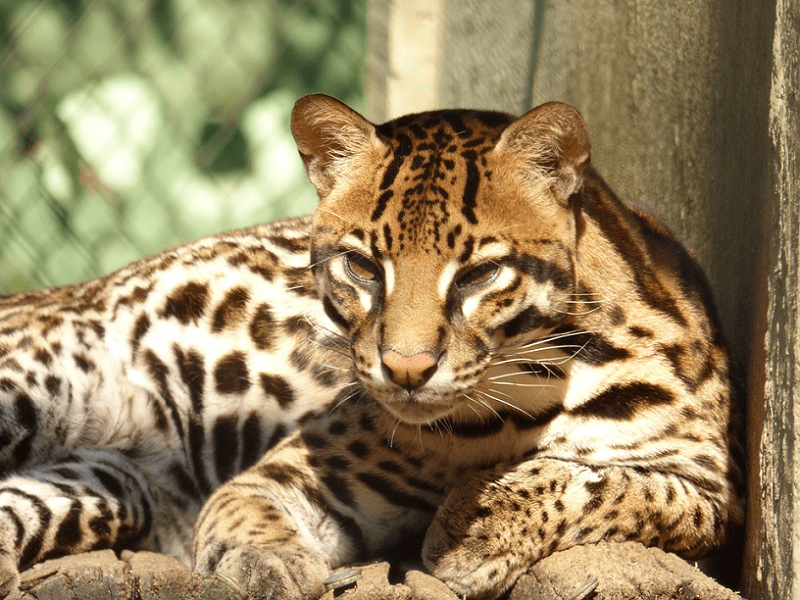
Ocelot Facts
- Perhaps most notably, the short term of Ocelot serves as the generally accepted common name of a truly stunning species of wildcat. The animal does have a few other general titles, though. These include Painted Leopard, Dwarf Leopard, McKenney’s Wildcat, and Tiger Cat.
- Within the scientific community, though, it’s perhaps better known by its technical designation. Unlike most such terms, however, it’s at least relatively simple for the layperson to pronounce. That’s because the amazing mammal holds the formal tag Leopardus pardalis.
- It received that comparatively simple official epithet due to the efforts of Carl Linaeus himself. The highly esteemed Swedish zoologist accomplished the first official recognition of it as a separate and distinct species. He achieved that scientifically noteworthy feat in the year 1758.
- Quite sadly, in the not so distant past, mankind widely hunted the magnificent animal for its pelt, which humans regarded as highly valuable. Thankfully, due to a more enlightened government, authorities banned this practice decades ago throughout its endemic territory.
- In an extremely pleasant twist of fate, while most wildcats see their numbers dwindling rapidly, the beautiful Ocelot stands somewhat apart. That’s because the creature holds the distinction of being one of the few wild felines that the IUCN currently lists as a Species of Least Concern.
- Previously, however, the stunning feline held the status of Endangered, until the year 1996. But, due to numerous concerted efforts at protecting the creature, its numbers managed to bounce back significantly. Now, though, it faces the potential threat posed by climate change.
Related Articles
Ocelot Physical Description
The fabulous Ocelot rarely fails to capture the interest and attention of those individuals fortunate enough to encounter one, especially in the wild. The wonder typically does so, however, due more to its beauty than sheer size. In that respect, it’s only of relatively moderate dimensions.
Concerning its overall appearance, it also follows a pattern common among many mammals, including its kindred. That’s the fact that it displays a certain amount of the physiological characteristic of sexual dimorphism. In its case, though, this only manifests to a moderate degree.
Females of the species attain a smaller average size than males. These rarely weigh as much as 25 lb (11.3 kg). The males, meanwhile, reach a weight of up to 34 lb (15 .5 kg). Both sexes nonetheless attain approximately the same average overall body length of between 22 – 39 in (55 – 100 cm).
That makes the magnificent species significantly smaller in size than most, but not all, wildcats. Nature’s not done with it, however. That’s true since the moderately impressive tail adds an additional 10 – 16 in (25.5 – 41 cm) to the total length of the feline. It also serves to add to its beauty.
In color, the fur of the gorgeous Ocelot also garners attention. This displays predominantly a tawny yellow with numerous black markings. Not to be outdone, the neck and belly display a white coloring. Meanwhile, its fur usually remains short on the belly but slightly longer on the back.
Yet, its distinctiveness does not simply end there. Further adding to its visual appeal, the small ears usually remain rounded. These also display a prominent white spot, creating a rather dramatic effect. The eyes most commonly show a brown color that reflects patterns of gold in bright light.
- Kingdom: Animalia
- Phylum: Chordata
- Class: Mammalia
- Order: Carnivora
- Family: Felidae
- Genus: Leopardus
- Species: L. paradis
Ocelot Distribution, Habitat, and Ecology
The breathtaking Ocelot apparently evolved as indigenous to a surprisingly extensive portion of the surface of the earth. Given its nature, though, the location of this zone of habitation won’t surprise many people. It’s range includes portions of North America, Central America and South America.
The mesmerizing product of natural evolution doesn’t appear within every part of these regions, though. It’s not known to live in Canada. The territory of the animal extends from Texas, in the United States, through Central America, and to all but the most southerly parts of South America.
Regrettably, population densities for the creature also vary somewhat widely throughout the entirety of that range. However, the highest known density seems to occur in the nation of Panama. In all areas, though, this particular animal inhabits an impressively wide range of habitats.
This flexibility seemingly contributed to the rebounding of its numbers from just a few decades ago. Its favored habitat types include such regions as rainforests, scrublands, mangrove forests, and even coastal marshes. It also prefers lower elevations, but some occur as high as 9,843 ft (3,000 m).
Like all of its known kindred, the breathtaking Ocelot also evolved to have an entirely carnivorous diet. Given its specific habitat preferences, and its own size, its primary prey consists of smaller creatures. Thankfully, however, its native range continues to have an abundance of these.
Those include such highly varied species as rabbits, rodents, fish, birds, opossums, armadillos, and occasionally small reptiles and sometimes even insects. Hunting activities typically occur during the evening and at night, but do sometimes take place during the day when necessary.
Species Sharing Its Range
Check out our other articles on 5 Rare Mind-Blowing Cloud Types, Spotted Handfish, Eye of the Sahara, White Witch Moth, Inaccessible Island Rail, Chatham Island forget-me-not, Green Iguana
